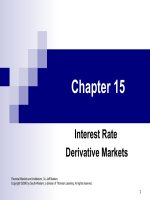Tài liệu Thị trường tài chính và các định chế tài chính_ Chapter 17 doc
Bạn đang xem bản rút gọn của tài liệu. Xem và tải ngay bản đầy đủ của tài liệu tại đây (319.69 KB, 37 trang )
1
Chapter 17
Commercial Bank Operations
Financial Markets and Institutions, 7e, Jeff Madura
Copyright ©2006 by South-Western, a division of Thomson Learning. All rights reserved.
2
Chapter Outline
Commercial banks as financial
intermediaries
Bank market structure
Bank sources of funds
Uses of funds by banks
Off-balance sheet activities
International banking
3
Commercial Banks as Financial
Intermediaries
Commercial banks serve all types of
surplus and deficit units
Offer deposit accounts with the size and
maturity characteristics desired by surplus
units
Repackage funds received from deposits to
provide loans of the size and maturity desired
by deficit units
4
Bank Market Structure
Banks are continuing to consolidate:
Interstate regulations were changed in 1994 to allow
banks more freedom to acquire banks across state
lines
Competition among banks increased
Banks needed to become more efficient as a means of
survival
Acquisitions were a convenient method to grow quickly
The number of banks today is about one-half that
existed in 1985
The largest 100 banks now represent about 75 percent
of all bank assets
5
Bank Market Structure (cont’d)
Bank participation in financial conglomerates
Some commercial banks have acquired other types of financial
service firms
Conglomerates are composed to various units offering
specialized services
Impact of the Financial Services Modernization Act
The Act gave banks and other financial service firms more
freedom to merge, without having to divest some of the financial
services that they acquired
The Act allowed financial institutions to offer a diversified set of
financial services
6
Bank Market Structure (cont’d)
Benefits of diversified services to individuals and firms
Individuals and firms have various financial needs that they can
now satisfy with one conglomerate
Some financial conglomerates specialize in the services desired
by individuals or large firms
Benefits of diversified services to financial institutions
Financial institutions can reduce their reliance on the demand for
any single service they offer
Diversification may result in less risk for the institution
The units of a financial conglomerate may generate some new
business just because they offer convenience to clients who
already rely on its other services
7
Bank Sources of Funds
A financial institution’s liabilities represent its sources of
funds
Transaction deposits
A demand deposit account (checking account) is offered to
customers who desire to write checks
A conventional account requires a small minimum balance and pays
no interest
A negotiable order of withdrawal (NOW) account provides
checking services as well as interest but requires a larger
minimum balance
Electronic transactions
About two-thirds of all employees in the U.S. have direct deposit
accounts
More than 60 percent of bank customers use ATMs
Debit cards and preauthorized debits can be used for recurring
monthly payments
8
Bank Sources of Funds (cont’d)
Savings deposits
Until 1986, Regulation Q restricted the interest rate
banks could offer on passbook savings
Ceilings prevented commercial banks from competing for
funds during periods of higher interest rates
An automatic transfer service (ATS) account allows
customers to maintain an interest-bearing savings
account that automatically transfers funds to their
checking account when checks are written
9
Bank Sources of Funds (cont’d)
Time deposits
Time deposits are deposits that cannot be withdrawn
until a specified maturity date
Retail certificates of deposit (CDs) require a
specified minimum amount of funds to be deposited for
a specified period of time
Annualized interest rates vary among banks and maturity
types
There is no organized secondary market
Depositors will normally forgo a portion of their interest as a
penalty for early withdrawal
10
Bank Sources of Funds (cont’d)
Time deposits (cont’d)
Certificates of deposit (cont’d)
Bull-market CDs reward depositors if the market performs well
Bear-market CDs reward depositors if the market performs poorly
Callable CDs can be called by the financial institution early
Pay a slightly higher interest rates, which compensates depositors for
risk
Negotiable certificates of deposit (NCDs):
Are offered by some large banks to corporations
Typically have short-term maturities
Typically require a minimum deposit of $100,000
Do not have a secondary market
11
Bank Sources of Funds (cont’d)
Money market deposit accounts (MMDAs):
Were created with the Garn-St Germain Act of 1982
Differ from conventional time deposits in that they do
not specify a maturity
Are more liquid than retail CDs
Normally pay a lower rate than retail CDs
Differ from NOW accounts in that they provide limited
check-writing ability
12
Bank Sources of Funds (cont’d)
Federal funds purchased
Federal funds purchased represent a liability to the borrowing
banks and an asset to the lending bank that sells them
Loans in the federal funds market are typically for one to seven
days
The intent of federal funds transactions is to correct short-term
fund imbalances experienced by banks
The interest rate charged in the federal funds market is the
federal funds rate
Typically between 0.25 percent and 1.00 percent above the T-bill
rate
Banks that are short of required reserves on the average over a
settlement period must compensate with additional reserves
13
Bank Sources of Funds (cont’d)
Borrowing from the Federal Reserve banks
The interest rate charged on loans from the Fed is the
discount rate
Loans from the discount window are commonly from
one day to a few weeks
The discount window is mainly used to resolve a
temporary shortage of funds
Banks commonly borrow in the federal funds market
instead of the discount window because the Fed may
disapprove of continuous borrowing by a bank
14
Bank Sources of Funds (cont’d)
Repurchase agreements
A repurchase agreement (repo) represents the sale of
securities by one party to another with an agreement to
repurchase the securities at a specified date and price
Banks use repos as a source of funds when they need funds just
for a few days
The bank sells some government securities to a corporation and
buys those securities back later
Repos occur through a telecommunications network connecting
large banks, corporations, government securities dealers, and
federal funds brokers
Repo transactions are typically in blocks of $1 million
The repo yield is slightly less than the federal funds rate









